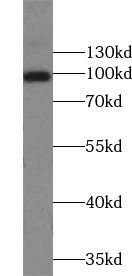Products
PPP1R15A antibody
| Synonyms: | Protein phosphatase 1 regulatory subunit 15A|Growth arrest and DNA damage-inducible protein GADD34|Myeloid differentiation primary response protein MyD116 homolog|PPP1R15A|GADD34 antibody | ||
| Catalogue No.: | FNab03293 | Reactivity: | Human, Mouse, Rat |
| Host: | Rabbit | Tested Application: | ELISA, WB, IHC, IF |
| Clonality: | polyclonal | Isotype: | IgG |
| Size | Price |
|---|---|
| 100µg | Inquiry |
- SPECIFICATIONS
- FIGURES
- CONDITIONS
- FAQS
- Product Name
- PPP1R15A antibody
- Catalogue No.
- FNab03293
- Size
- 100μg
- Form
- liquid
- Purification
- Immunogen affinity purified
- Purity
- ≥95% as determined by SDS-PAGE
- Clonality
- polyclonal
- Isotype
- IgG
- Storage
- PBS with 0.02% sodium azide and 50% glycerol pH 7.3, -20℃ for 12 months(Avoid repeated freeze / thaw cycles.)
- Immunogen
- protein phosphatase 1, regulatory(inhibitor) subunit 15A
- Alternative Names
- Protein phosphatase 1 regulatory subunit 15A|Growth arrest and DNA damage-inducible protein GADD34|Myeloid differentiation primary response protein MyD116 homolog|PPP1R15A|GADD34 antibody
- UniProt ID
- O75807
- Observed MW
- 100 kDa
- Tested Applications
- ELISA, WB, IHC, IF
- Recommended dilution
- WB: 1:200-1:1000; IHC: 1:20-1:200; IF: 1:20-1:200
 K-562 cells were subjected to SDS PAGE followed by western blot with FNab03293(GADD34 antibody) at dilution of 1:600
K-562 cells were subjected to SDS PAGE followed by western blot with FNab03293(GADD34 antibody) at dilution of 1:600
 Immunohistochemistry of paraffin-embedded human pancreas cancer using FNab03293(GADD34 antibody) at dilution of 1:100
Immunohistochemistry of paraffin-embedded human pancreas cancer using FNab03293(GADD34 antibody) at dilution of 1:100
 Immunofluorescent analysis of PC-3 cells using FNab03293( GADD34 Antibody) at dilution of 1:50 and Alexa Fluor 488-conjugated Goat Anti-Rabbit IgG(H+L)
Immunofluorescent analysis of PC-3 cells using FNab03293( GADD34 Antibody) at dilution of 1:50 and Alexa Fluor 488-conjugated Goat Anti-Rabbit IgG(H+L)
- Background
- GADD34, also named PPP1R15A, belongs to the PPP1R15 family. GADD34 can be triggered as a direct target of activating transcription factor4(ATF4) under ER stress, it plays a pivotal role in the recovery of cells from shut-down of translation induced by ER stress. It recruits the serine/threonine-protein phosphatase(PP1) to dephosphorylate the translation initiation factor eIF2alpha, thereby reversing the shut-off of protein synthesis initiated by stress-inducible kinases and facilitating recovery of cells from stress. GADD34 down-regulates the TGF-beta signaling pathway by promoting dephosphorylation of TGFB1 via PP1. It may also promote apoptosis by inducing TP53 phosphorylation on 'Ser-15'. Starvation-induced expression of GADD34 reduced mTOR activity and induced autophagy in wild-type mice, but not in GADD34 KO mice. Molecular weight of GADD34 appears to be about 100 kDa which was confirmed in GADD34 KO mice and drug treated cells, despite the predicated MW of 73 kDa, and this antibody primarily recongize the 100 kDa band.
How many times can antibodies be recycled?
First, usually it's not suggested to recycle antibodies. After use, buffer system of antibodies has changed. The storage condition of recycled antibodies for different customers also varies. Thus, the performance efficiency of recycled antibodies can’t be guaranteed. Besides, FineTest ever conducted the antibody recycling assay. Assay results show recycling times of different antibodies also varies. Usually, higher antibody titer allows more repeated use. Customers can determine based on experimental requirements.
Notes: After incubation, we recycle rest antibodies to centrifuge tube and store at 4℃. High titer antibodies can be stored for a minimum of one week. Reuse about three times.
What are components of FineTest antibody buffer?
Components of FineTest antibody buffer are usually PBS with proclin300 or sodium azide, BSA, 50% glycerol. Common preservative is proclin300 or sodium azide, which is widely applied in the lab and industry.
How about the storage temperature and duration of FineTest antibodies?
Most antibodies are stored at -20℃. Directly-labeled flow cytometry antibodies should be stored at 2 - 8℃. The shelf life is one year. If after sales issues for purchased antibodies appear, return or replacement is available. Usually, antibodies can be still used after the one-year warranty. We can offer technical support services.
Is dilution required for FineTest antibodies? What’s the dilute solution?
Directly-labeled flow cytometry antibodies are ready-to-use without dilution. Other antibodies are usually concentrated. Follow the dilution ratio suggested in the manual. Dilute solution for different experiments also varies. Common antibody dilution buffers are acceptable(e.g. PBST, TBST, antibody blocking buffer).
How to retrieve antibodies for immunohistochemistry?
Common retrieval buffers: Tris-EDTA Buffer(pH 9.0); Citrate Buffer(pH 6.0)
Heat induced antibody retrieval:
Method 1: Water-bath heating: Put the beaker with retrieval buffer and slide in the boiling water bath. Keep the boiling state for 15min. Naturally cool to room temperature;
Method 2: Microwave retrieval: Put the beaker with retrieval buffer and slide in the microwave oven. Heat at high power for 5min, Switch OFF for 3min, Heat at medium power for 5min. Naturally cool to room temperature.
How to choose secondary antibodies?
(1) Secondary antibodies react with primary antibodies. Thus, secondary antibodies should be against host species of primary antibodies. E.g. If the primary antibody is derived from rabbit, the relevant secondary antibody should be against rabbit. E.g. goat anti rabbit or donkey anti rabbit.
(2) Choose secondary antibody conjugates according to the experimental type, e.g. ELISA, WB, IHC etc. Common enzyme conjugated secondary antibodies are labelled by HRP, AP etc. Fluorescin or dye labelled secondary antibodies are applied in immunofluorescence and flow cytometry(e.g. FITC, Cy3).
